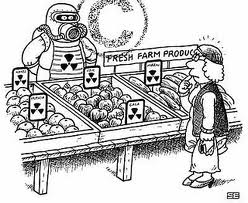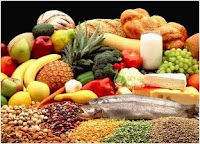GM foods: Some common misconceptions
Was this information helpful?
Saturday, May 21, 2011
May 19th
Here are two lists of (alleged) misconceptions about genetically modified foods from two somewhat biased views. Be sure to read them both.
Tuesday, May 10, 2011
May 4th
Once again, another really well done picture. But how legitimate are concerns related to the effect of genetically modified foods on living organisms, safe to eat though these things hopefully are? Will it have a significant impact on the world around us?

This is from an official Dole Website.
Sketchy.
Sure, it will make little kids want to have bananas and pineapples, but someone who is really against genetic modification could have a field day with this, cute though it may be.
Anyways, are genetically modified foods detrimental to the environment? There has been plenty of evidence to suggest that they are, and really, it's quite difficult to find out the truth... the corporations will, of course, say that they are not, that everything is under perfect control. Many people will disagree, but many of said people do not actually have any scientific evidence to back their point, though the point that many of them take could be interpreted as being entirely fair- that we should not mess with mother nature.
But we do mess with Mother Nature. Every day, in fact, in so many circumstances so obvious that they need not be listed (and the list would be bordering on endless). We started messing with Mother Nature the day we developed opposable thumbs and started making tools. (This is called Bioethics. It's extremely interesting, actually).
Tuesday, May 3, 2011
May 3rd
http://www.worldpress.org/Africa/737.cfm#down
Here is a link to a genuinely interesting article on genetically modified foods in Africa.
So what should it come to in the end? Who knows? Is anybody really in the right here?
Here is a link to a genuinely interesting article on genetically modified foods in Africa.
So what should it come to in the end? Who knows? Is anybody really in the right here?
Friday, April 29, 2011
Some Links
Here are some links to some websites with good information about GM foods that you may not have known.
Wednesday, April 20, 2011
Over- Reactions And Under- Reactions
The author has seen many (admittedly unfair) editorial cartoons about genetically modified foods. For example:
This is an over- reaction.
Your "Frankenfood" apple is not going to bite you back. In fact, it is probably not going to do you any physical damage at all.
This is also an over-reaction. Once again, genetically modified food is perfectly safe- to eat. All the paranoia surrounding it is just that. Paranoia.
This is an over- reaction.
Your "Frankenfood" apple is not going to bite you back. In fact, it is probably not going to do you any physical damage at all.
This is also an over-reaction. Once again, genetically modified food is perfectly safe- to eat. All the paranoia surrounding it is just that. Paranoia.
(Actually, this one's pretty cool.)
Good Grief.
If you eat foods that are bought at your local supermarket, you eat genetically modified food. And if you are reading this, you probably haven't transformed into a gigantic mutant piece of celery; don't be paranoid about the effects it has on you, as a consumer.
Although gigantic mutant plants would, once again, be pretty cool. Like in The Day Of The Triffids by John Wyndham.
But unfortunately for coolness, that is not the problem.
This is the man-eating monster.
Miss the Triffids?
Tuesday, March 15, 2011
Just an example
__________________________
In 1996, approximately 4.3 million acres of agricultural land where devoted to the growing of genetically modified crops.
This was a short, simplistic slideshow on a certain effect of GM foods that many people are unaware of. Though it is, once again, very simplistic, it gets the information across well enough.
Some information has been repeated from the previous post. Sorry.
Some information has been repeated from the previous post. Sorry.
In 1996, approximately 4.3 million acres of agricultural land where devoted to the growing of genetically modified crops.
In 2000, approximately 109 million acres of agricultural land where devoted to the growing of genetically modified crops. 109 million acres is quite nearly twice the size of the United Kingdom.
A Large And Growing Method
(Pardon the pun)
(Pardon the pun)
Do you enjoy extra-large, extra-sweet fruits? Vegetables that have not been sprayed with pesticide? Perhaps the idea of food that grows faster, too, if you are an agricultural worker, or very hungry, appeals. Crops that will not freeze if that autumn frost hits a bit early? Very nice. What about foods containing extra vitamins, to treat malnutrition? Being able to eat a strawberry instead of taking a shot?
It all sounds very nice, doesn't it? And it is. BUT IT IS NOT WORTH THE CONSEQUENCES! And here is why.
The Big Catch
Actually, this slide ought to be entitled “A big catch”, rather than “The big catch”, for there is an incredible number of problems to do with genetic modification of food, specifically here the genetic modification of food crops, amongst which are ethics and the safety of the consumers. There are also environmental concerns, and though the preservation of our habitat is equally important compared to the people who depend upon it, it is the impacts of genetic modification on society that will here be discussed.
So, where to begin? The preliminary fact of importance is the high cost of genetic modification. Only large companies can afford to do it. (And just who holds most of the large companies? Yep, you guessed it.) So, to simplify the situation, a large, wealthy company from a large, wealthy country will grow gigantic, pest resistant, and often better tasting food crops in such an area in which they can be grown. As for any local farmers, well, they are hopelessly outmatched. They cannot compete. To make matters worse, the profits made by the large, wealthy companies return to their large, wealthy countries, leaving little behind.
Of course, many people will say that this may be all right; these huge quantities of genetically modified foods may be used to feed said broke farmers. But, as anyone could figure out, the vast majority of the produce will go directly and exclusively towards wealthy consumers, and whatever charitable compensation received by the third world will be insufficient to sustain them.
Friday, January 14, 2011
1st posting
In 1996, approximately 4.3 million acres of agricultural land were devoted to the growing of genetically modified crops.
In 2000, approximately 109 million acres of agricultural land were devoted to the growing of genetically modified crops. 109 million acres is quite nearly twice the size of the United Kingdom.
It cannot, therefore, be denied that genetically modified foods are a large, and growing, industry. And why wouldn't it be? Who doesn't like extra-large, extra-sweet fruits, and vegetables that have not been sprayed with pesticide? Food that grows with greater speed appeals too, if you are an agricultural worker or very, very hungry. Crops that will not turn into popsicles if that first frost hits early? Very nice. And what about extra vitamins, to treat malnutrition with greater efficiency? What about being able to eat a strawberry instead of taking a shot?
It sounds good, doesn't it? But it is all a great deal more complicated than that.
Subscribe to:
Posts (Atom)












